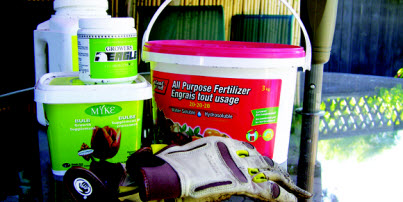Fertilizer is an artificial way of adding nutrients to the soil in much the same way as we take vitamins and minerals to supplement our human diets. Just as in humans, a healthy diet is the best medicine, so is a healthy soil, rich in organics and minerals, is the best guarantee of a healthy plant.
Using sunlight to fuel the activity, plants take carbon dioxide from the air and use the carbon to make sugars or glucose in a process called photosynthesis.
Plants need macro-nutrients; nitrogen, phosphorus and potassium. Plants also need, in lesser quantities, calcium, iron, magnesium and sulfur, plus a long list of micro-nutrients, such as copper, zinc, manganese, boron, molybdenum, chlorine and nickel and, it is suspected, others in amounts so small that we haven’t yet detected them.
While commercial fertilizers contain “N-P-K” (nitrogen, phosphorous and potassium), plants really do better when they are able to process trace elements from the soil.
Having said this, most of us fertilize to get a good strong growth spurt, but many questions loom. Timing is the first issue. Fertilize when the plants are in strong growth mode, then back off as they mature.
For perennials, that would be the end of July and early August to allow the plant to begin getting ready for winter. Hothouse annuals can be fertilized right to the end of summer and, if you bought plants that were already potted up in soilless mix, the fertilization regime must be kept up throughout the summer and into the fall because the soilless mix contains no nutrients. A half-strength dose of fertilizer every time you water is okay for these annuals.
If it’s cloudy, wait. Plants need warmth and sunlight to process the products you are sending them. Potted plants can develop a buildup of mineral salts from fertilizing in periods of low light or cold weather. That’s why it is recommended that you stop fertilizing houseplants in late fall (November) and don’t start again until March when the days get longer.
Knowing what to buy is another challenge. There are many fertilizer combinations on the market, all touting their ability to promote bloom or fruit, but for most purposes a balanced fertilizer, where all three numbers are equal, will give you good results. In other words, a fertilizer that is labelled 20-20-20 contains 20 per cent of each of the macro-nutrients or 10-15-10 would have 10 per cent nitrogen, 15 per cent phosphorus and 10 per cent potassium.
Don’t over-fertilize. Not only can you burn the plant’s roots and actually cause them to wither and die, but you’re probably wasting money, at least on the nitrogen, which leaches away. To be safe, just follow the product directions. I fertilize only my annuals and roses and sometimes, in early spring, any two-year or older plant that looks a little sickly.
What do all those numbers mean? Well, N is for nitrogen, the first number on the list. Nitrogen promotes leafy growth. As mentioned, it is readily leached through the soil and needs to be replenished the most. However, take care with fruiting plants, such as tomatoes, as too much nitrogen can result in a leafy, but barren plant.
The P in the list stands for phosphorus, which promotes fruiting and flowering and strong roots.
Finally, K stands for potassium or potash and this is the nutrient that provides overall health and vigour.
The secondary macro-nutrients are usually present in your soil, but they need organic or carbon-based materials to promote the growth of fungi and other micro-organisms to help break them down into chemicals the plant can process.
So now that you know the whole story, you can decide for yourself when and how much to fertilize. Just remember, the more growth, the more watering you will need to do and aphids love nice, juicy, new growth, as does powdery mildew.
You can keep pouring the old N-P-K to the soil (and if you do, use Sea Magic or some other seaweed additive to help the plant absorb the nutrients), or you can amend your soil with compost, decayed horse manure, dead leaves and the odd doses of sand or good old Elm Creek silt and let nature take its slower, but much surer, course.



